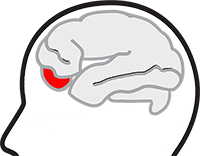Treatments for cluster headache:
- We will start with acute treatments.
- Then, medicinal preventative treatments.
- After that, non-medicinal treatments.
- And then new treatments.
Other treatments are also discussed here:
- Invasive treatments.
- The only transitional treatment.
- Some alternative treatments.
- And finally, the treatments for which studies are underway.
Acute treatments
Conventional painkillers are completely ineffective!
Even the strongest opiates, such as morphine, are generally not very effective, if not ineffective in stopping the attack.
In addition, this kind of medication, often with increasing and more and more frequent doses (addiction), can cause medication-induced headaches!
Finally, opiates also cause dependence (addiction) and the patient will experience difficulty quitting.
Two acute treatments are currently considered effective:
- Imitrex SC ® :
Subcutaneous injection of sumatriptan. Note that there is no generic equivalent in Belgium..
- 100% oxygen:
Many doctors still do not prescribe oxygen to their patients to stop attacks. However, it is the method favoured by the prestigious Journal of the American Medical Association.
Often patients have had to suggest oxygen therapy to their doctor themselves!
Finally, few patients treated with oxygen are suitably trained to use it.
An old treatment is still sometimes used:
- Cafergot ® :
Ergotamine tartrate (Cafergot ®) is rarely offered anymore because of its incompatibility with sumatriptan as well as the risks of fibrosis and ergotism.
Preventative or prophylactic medicinal treatments:
- Verapamil:
- The medicines made from this molecule were initially used for:
- the treatment of angina pectoris in all its forms.
- in prevention and treatment of certain heart rhythm disorders.
However, it is the prophylactic treatment which is currently considered to be the most effective for cluster headache.
- The medicines made from this molecule were initially used for:
- Infiltration of the Greater Occipital Nerve (GON) or Arnold ‘ s nerve:
Several studies demonstrate that electrical stimulation of the trigeminal nerve induces reflex responses in the muscles of the neck, which has led to the concept of the “trigeminocervical reflex”.
On the other hand, other studies show that there is a central convergence between the fibres of the trigeminal (branch VI) and greater occipital nerves.
This suggests a possible involvement of the cervical and occipital nerves during cluster headache attacks.
Several solutions have been envisaged based on this data, in particular “invasive” solutions (see below) such as occipital implants as well as the GON block.
- Topiramate:
Topiramate is a second generation of anti-epileptic drug. It is generally used as a treatment for migraine but also for cluster headache.
It is knowed in France under the name of Epitomax ® and in Belgium under the name of Topamax ®.
- Lithium :
Initially intended to treat bipolar disorders, lithium carbonate can be used as a second-line treatment for the prophylactic treatment of cluster headache.
This treatment is more often used in chronic patients because its implementation is long and gradual.
- Sodium Valproate:
It was initially used as an anticonvulsant and sedative, intended to treat epilepsy and bipolar disorder. It is also used as a treatment for cluster headache.
DEPAKOTE + PREGNANCY = FORBIDDEN Not to be used by girls, teenage girls, women that are pregnant or of childbearing age, expect in the case of the failure of other treatments
- Ergotamine derivatives:
Ergotamine derivatives are a pharmacological class whose basic structure is ergoline. These molecules are used in the treatment of migraine attacks in particular.
A number of these medications are no longer on the market!
- Antidepressants :
There does not seem to be any specific study regarding cluster headache and antidepressants.
Clinical experience has shown that they are frequently prescribed for patients who are unresponsive to, or unable to take other treatments.
Non-medicinal treatments:
- Vagus nerve stimulation:
Non-invasive stimulation of the vagus nerve appears to be promising.
- Transcranial direct-current stimulation – tDCS :
Promising as a preventative treatment for cluster headache or chronic cluster headache.
New preventive treatments:
- CGRP antibody:
CGRP = Calcitonin Gene-Related Peptide.
The cell bodies of the trigeminal ganglion are the main source of CGRP production.
During cluster headache attacks caused by administration of nitroglycerine, a visible increase in the level of CGRP in the blood plasma was measured.
When CGRP is administered to cluster headache patients, attacks are caused in episodic patients in the active phase and (slightly less) in chronic patients, but not in episodic patients in the remission phase.
The idea of making antibodies from CGRP came from these two facts.
Invasive Treatments:
- Hypothalamic deep brain stimulation:
The implantation of an electrode to the hypothalamus makes it possible to obtain a reduction of 50% in the number of attacks in approximately 60% of cases.
- Stimulation of the greater occipital nerve:
Allows for a 50% reduction in the frequency of attacks in around 70% of cases.
- Sphenopalatine ganglion stimulation:
…
Bridge treatment:
- Medrol :
Often has a remarkable efficiency.
Oral treatment is a gradual dose reduction regime (Kudrow’s diagram).
There is an intravenous treatment which is to be carried out in a hospital (very high doses).
Alternative treatments:
- Acupuncture:
Very positive results for some, no effect for others. In any case, there is no contraindication.
- Kudzu root : While Kudzu powder doesn’t do any harm, it doesn’t do any good for the wallet, and no studies have proven it works.
- Capsaicin nasal spray :
In a clinical trial conducted in 1993, researchers from Boston demonstrated that capsaicin nasal spray can ease a cluster headache.
- Myotherapy:
Myotherapy is a purely manual therapy of the “mobilization” kind, never exceeding the physiological range of the joints. It is used to treat persistent post-traumatic contractures which are caused by many conditions
Treatments for which studies are underway:
- Psilocybin:
A study is underway in the United States
- LSD:
A study is underway in Switzerland


